Localizing Sustainable Development Goal 6: An Assessment of Equitable Access to Sanitation in a Brazilian Metropolitan Region
Abstract
1. Introduction
2. Materials and Methods
2.1. Materials
2.2. Methodological Procedures
2.2.1. Estimation of the Current Situation of Access to Sanitation Facilities in the RMBH as a Whole
- The PNAD and Continuous PNAD were used to trace the evolution of access levels to sanitation facilities in the RMBH until the most recent period available. It was possible to estimate for each year of the period 2010–2018 the access levels to sewerage or septic tanks connected to sewer systems (both classified as “improved facilities” by the JMP) and to private toilets in the households of the RMBH as a whole (the criterion that distinguishes the “limited” and “basic” levels). Therefore, the following procedures were followed. The “proportion of the population with access to sewerage or septic tank connected to sewer system” was estimated for 2010 from the Demographic Census of that same year. This variable was computed by adding the population with access to sewerage to 37% of the population using septic tanks. This correction in the proportion of the population with septic tanks is equivalent to the proportion of users of septic tanks connected to sewer systems, according to the 2011 edition of the National Household Sample Survey (PNAD). This procedure was necessary, as the 2010 Census makes no distinction between septic tanks connected and those not connected to sewer systems. From 2011 to 2015, data from PNAD were used and, from 2016 to 2018, data from the Continuous PNAD were used, referring to the variable “sewerage or septic tank connected to sewer system”.
- The variable “proportion of the population with access to a private toilet” was composed of different data sets, including the variable “private toilet” of the 2010 Demographic Census; “toilet or private bathroom” of the PNADs, from 2011 to 2015; “bathroom, toilet or hole for dejections of exclusive use” of the 2016 edition of the Continuous PNAD; and “private toilet” of the 2017 and 2018 editions of the Continuous PNAD.
2.2.2. Estimation of Access to “At Least Basic” Sanitation Services in the Municipalities of the RMBH and by Different Population Subgroups
2.2.3. Projection of the Year of the Universalization of “At Least Basic” Sanitation Services in the RMBH Municipalities
2.2.4. Inequality Index Formulation
2.2.5. Intersectional Analysis of Inequalities in the Access to Sanitation Services in the RMBH Municipalities
3. Results
3.1. Current Situation of Access to Sanitation Facilities in the RMBH as a Whole
3.2. Access to “At Least Basic” Sanitation Services in the Municipalities of the RMBH and by Different Population Subgroups
3.3. Universalization of “At Least Basic” Services in the RMBH Municipalities
3.4. Inequality Index
3.5. Inequalities in the Access to Sanitation Services between Population Subgroups in the RMBH Municipalities Considering Intersecting Forms of Inequality
4. Discussion
5. Conclusions
Author Contributions
Funding
Conflicts of Interest
References
- Ministério das Cidades. Plano Nacional de Saneamento Básico—PLANSAB. Available online: http://www.cidades.gov.br/images/stories/ArquivosSNSA/Arquivos_PDF/plansab_06-12-2013.pdf (accessed on 20 July 2016).
- Torres, H.G.; Marques, E.; Ferreira, M.P.; Bitar, S. Pobreza e espaço: Padrões de segregação em São Paulo. Estud. Av. 2003, 17, 97–128. [Google Scholar] [CrossRef]
- Brito, F.; Souza, J. Expansão urbana nas grandes metrópoles: O significado das migrações intrametropolitanas e da mobilidade pendular na reprodução da pobreza. São Paulo Perspect. 2005, 19, 48–63. [Google Scholar] [CrossRef][Green Version]
- Maricato, E. Metrópoles desgovernadas. Estud. Av. 2011, 25, 7–22. [Google Scholar] [CrossRef][Green Version]
- Lago, L.C. Desigualdades e Segregação na Metrópole: O Rio de Janeiro em Tempo de Crise, 2nd ed.; Letra Capital: Rio de Janeiro, Brasil, 2015. [Google Scholar]
- Nahas, M.I.P.; Moura, A.S.A.; Carvalho, R.C.; Heller, L. Desigualdade e Discriminação no Acesso à Água e ao Esgotamento Sanitário na Região Metropolitana de Belo Horizonte; Cad. Saúde Pública: Minas Gerais, Brasil, 2019; Volume 35, p. e00100818. [Google Scholar] [CrossRef]
- Fundação João Pinheiro. Centro de Estudos Históricos e Culturais. Saneamento Básico em Belo Horizonte: Trajetória de 100 Anos—Os Serviços de Água e Esgoto; Fundação João Pinheiro: Belo Horizonte, Brasil, 1997.
- Mendonça, J.G.; Costa, H.S.M.; Borges, M.R. Organização social do território e formas de provisão de moradia na RMBH. In Belo Horizonte: Transformações na Ordem Urbana, 1st ed.; Andrade, L.T., Mendonça, J.G., Diniz, A.M.A., Eds.; Letra Capital/Observatório das Metrópoles/PUC-Minas: Belo Horizonte, Brazil, 2015; pp. 235–265. [Google Scholar]
- Heller, L. Saneamento e Saúde; Organização Pan-Americana da Saúde—OPAS: Brasilia, Brasil, 1997. [Google Scholar]
- United Nations Development Group. UN-Habitat, Global Taskforce of Local and Regional Governments and UNDP. In Localizing the Post-2015 Agenda: Dialogues on Implementation; United Nations Development Group: New York, NY, USA, 2014; Available online: https://www.uclg.org/sites/default/files/dialogues_on_localizing_the_post-2015_development_agenda.pdf (accessed on 10 February 2020).
- GTF-SDGs/UN-Habitat/UNDP. Global Taskforce of Local and Regional Governments, UN-Habitat and UNDP. Roadmap for Localizing the SDGs: Implementation and Monitoring at Subnational Level. 2016. Available online: https://www.global-taskforce.org/roadmap-achieving-sdgs-local-level (accessed on 12 February 2020).
- Messias, R.; Vollmer, J.G.; Sindico, F. 2018 Report—Localizing the SDGs: Regional Governments Paving the Way; Regions4 Sustainable Development: Brussels, Belgium, 2018. [Google Scholar]
- UCLG. Towards the Localization of the SDGs (Local and Regional Governments Report to the 2018 HLPF); 2nd Report; United Cities and Local Governments (UCLG): Barcelona, Spain, 2018. [Google Scholar]
- Schuthof, R.; Kuhn, S.; Morrow, R.; Kotler, A. 15 Pathways to Localise the Sustainable Development Goals—Inspiration from Cities Implementing Local Actions Contributing to Global Goals; ICLEI European Secretariat: Freiburg, Germany, 2019. [Google Scholar]
- Blanco, C., Jr.; Pires, C.; Amaral, M. Metropolitan Localized Data in Greater Belo Horizonte, Brazil: A Participatory Guide to Better Governance. Trends—Thematic Research Network on Data and Statistics Local—Data Action Solutions Initiative 2018–2019 Microgrant Program. 2019. Available online: https://www.sdsntrends.org/research/2019/4/15/local-data-action-brazil-belo-horizonte?rq=belo%20horizonte#read (accessed on 16 July 2020).
- Institute for Housing and Urban Development Studies (IHS)—Erasmus University Rotterdam. Available online: https://www.ihs.nl/en/resources/library/sdg-11-knowledge-hub/publications-localizing-sdg-11 (accessed on 17 July 2020).
- Patole, M. Localization of SDGs through Disaggregation of KPIs. Economies 2018, 6, 15. [Google Scholar] [CrossRef]
- WHO/UNICEF/JMP. Progress on Drinking Water, Sanitation and Hygiene: 2017 Update and SDG Baselines; World Health Organization (WHO); The United Nations Children’s Fund (UNICEF): Geneva, Switzerland, 2017. [Google Scholar]
- WHO/UNICEF. Joint Monitoring Programme for Water Supply, Sanitation and Hygiene. Available online: https://washdata.org (accessed on 17 July 2020).
- IBGE. Instituto Brasileiro de Geografia e Estatistica. In Principais Diferenças Metodológicas Entre as Pesquisas PME, PNAD e PNAD Contínua; IBGE: Rio de Janeiro, Brazil, 2015. Available online: ftp://ftp.ibge.gov.br/Trabalho_e_Rendimento/Pesquisa_Nacional_por_Amostra_de_Domicilios_continua/Nota_Tecnica/Nota_Tecnica_Diferencas_Metodologicas_das_pesquisas_PNAD_PME_e_PNAD_Continua.pdf (accessed on 7 April 2020).
- Rezende, S.; Ribeiro, A.J.F. A Utilização dos Dados Demográficos em Saneamento—UMA Aplicação ao Estado de Minas Gerais. In Anais do XI Seminário Sobre a Economia Mineira, Proceedings of the 11th Seminar on the Economy of Minas Gerais, Diamantina, Brasil, 24–27 August 2004; Cedeplar/Universidade Federal de Minas Gerais: Belo Horizonte, Brasil, 2004. [Google Scholar]
- Ministério do Desenvolvimento Social e Combate à Fome. Questões Metodológicas Acerca do Dimensionamento da Extrema Pobreza no Brasil Nos Anos 2000. Estudo Técnico SAGI. 2014. Available online: https://fpabramo.org.br/acervosocial/wp-content/uploads/sites/7/2017/08/413.pdf (accessed on 14 March 2020).
- WWAP (UNESCO World Water Assessment Programme). The United Nations World Water Development Report 2019: Leaving No One Behind; UNESCO: Paris, France, 2019. [Google Scholar]
- WHO/UNICEF/JMP. Task Force on Monitoring Inequalities for the 2030 Sustainable Development Agenda (Meeting Report). 2015. Available online: https://washdata.org/file/407/download+&cd=12&hl=pt-BR&ct=clnk&gl=br&client=firefox-b-d (accessed on 10 October 2019).
- OPAS (Organización Panamericana de la Salud). La Agenda 2030 para el Abastecimiento de Agua, el Saneamiento y la Higiene en América Latina y el Caribe: Una Mirada a Partir de los Derechos Humanos; OPAS: Washington, DC, USA, 2019. [Google Scholar]
- Barros, R.; Lam, D. Income and Educational inequality and Children’s Schooling Attainment. In Opportunity Foregone: Education in Brazil, 1st ed.; Birdsall, N., Sabot, R.H., Eds.; Inter-American Development Bank; John Hopkins University Press: Washington, DC, USA, 1996; pp. 337–366. [Google Scholar]
- OECD. Education at a Glance 2018: OECD Indicators; OECD Publishing: Paris, France, 2018; pp. 88–101. [Google Scholar] [CrossRef]
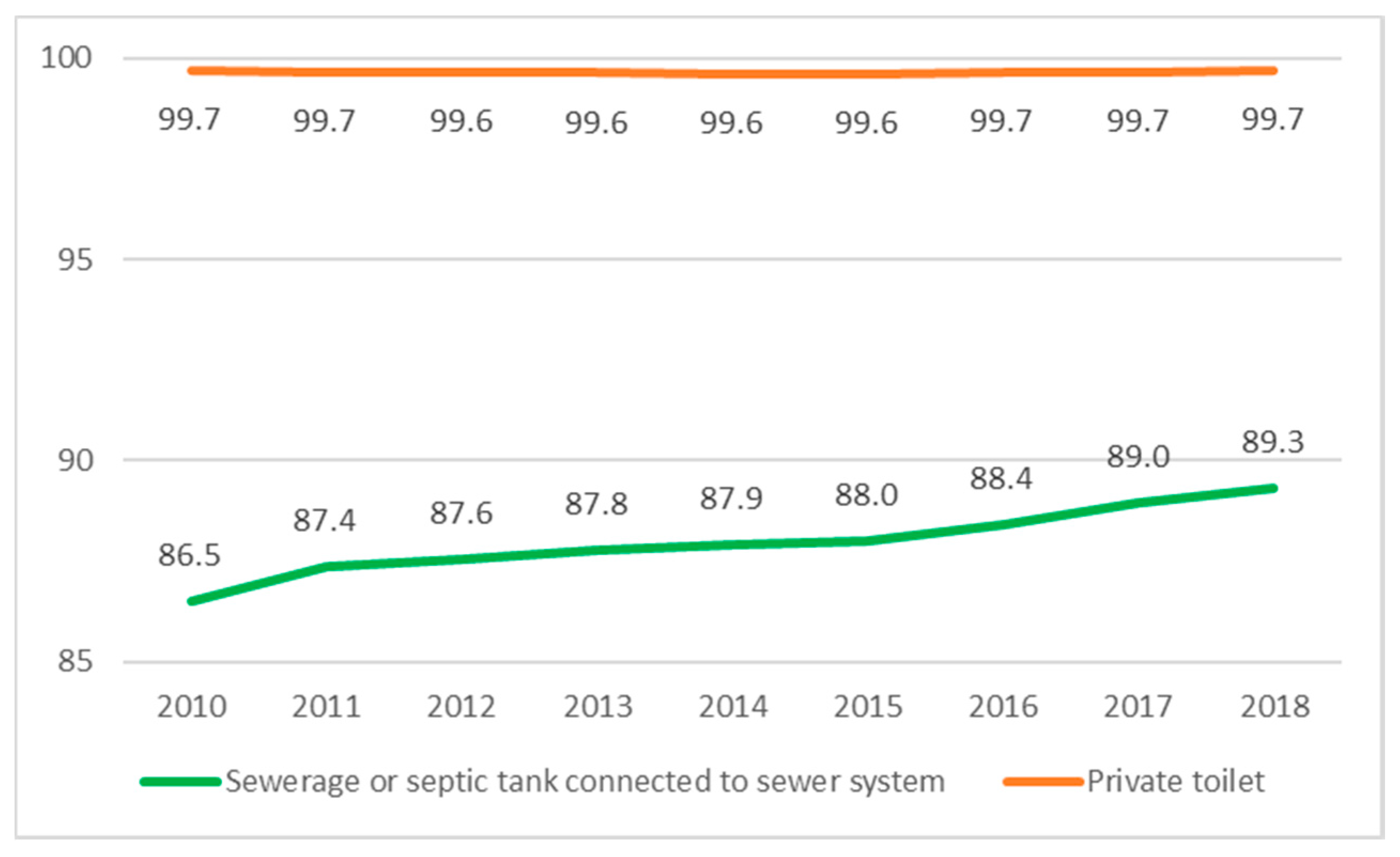

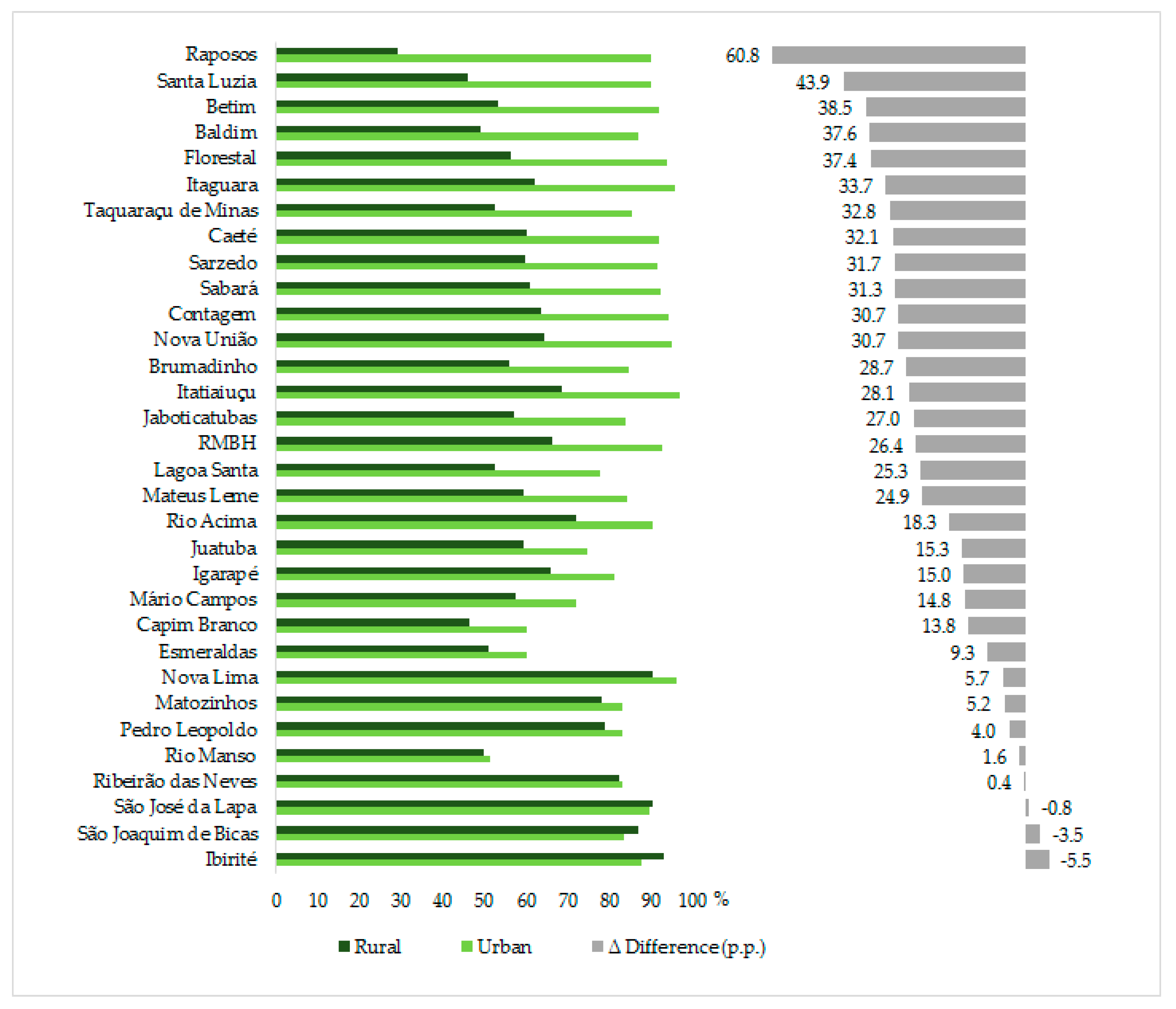
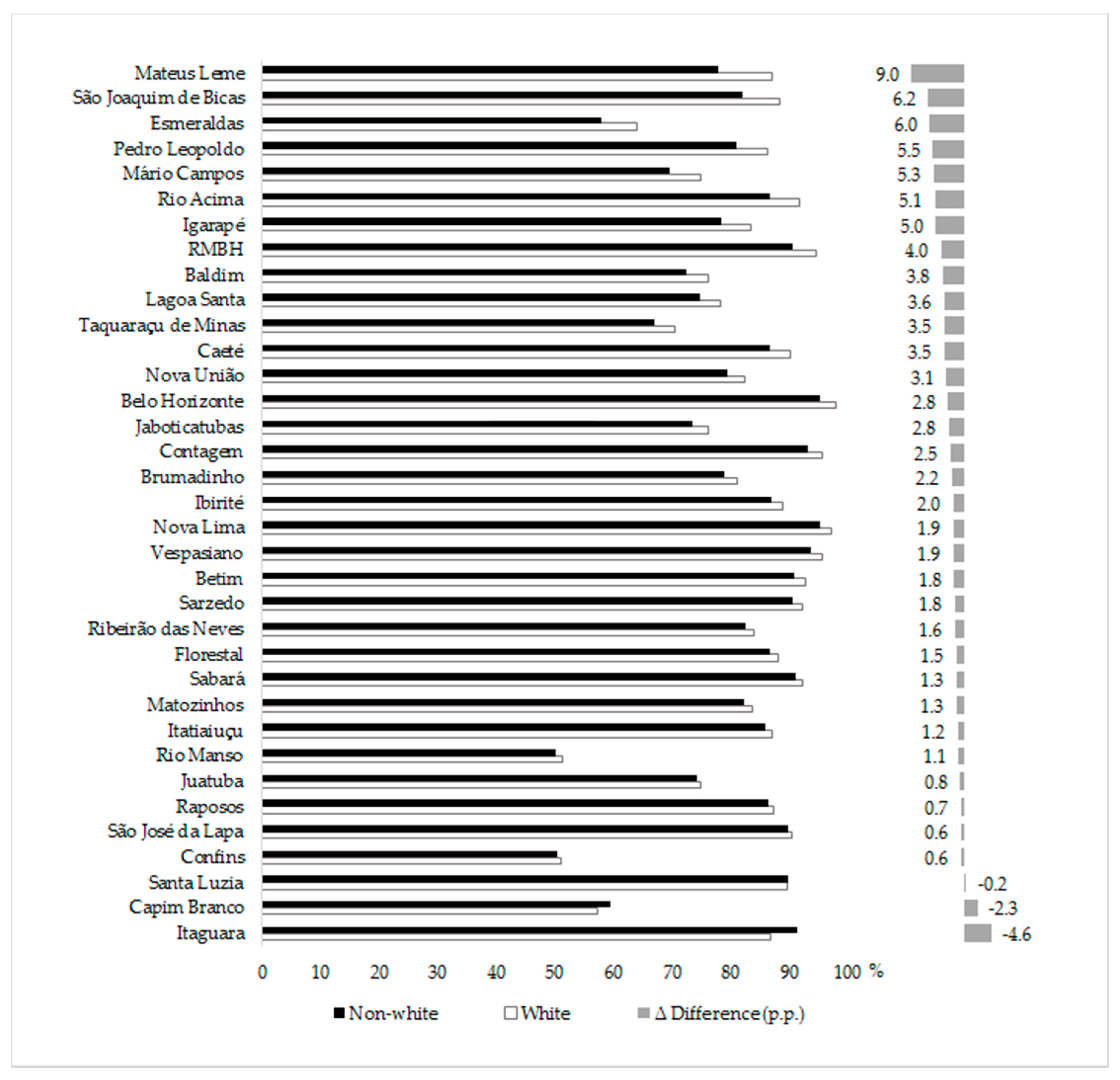
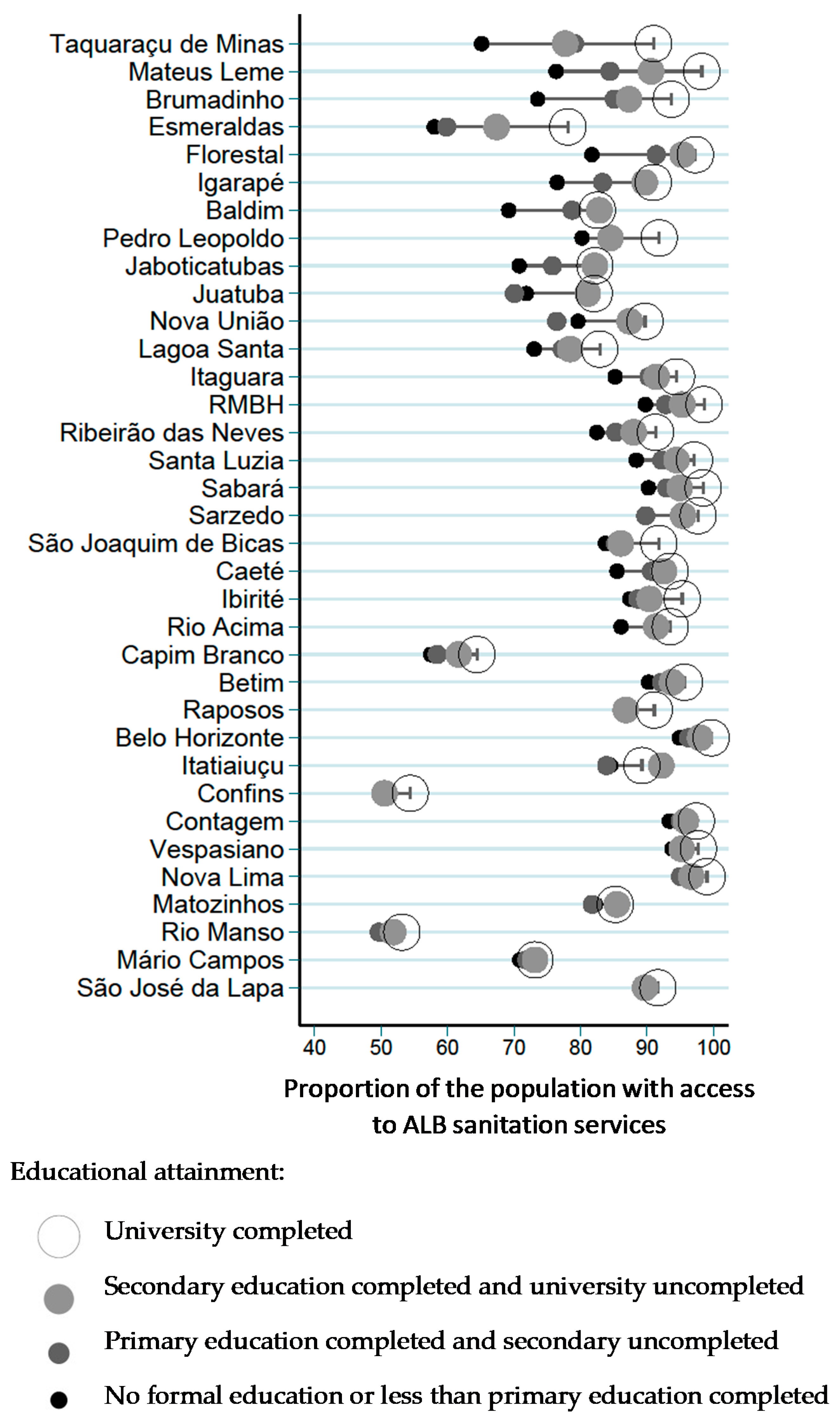
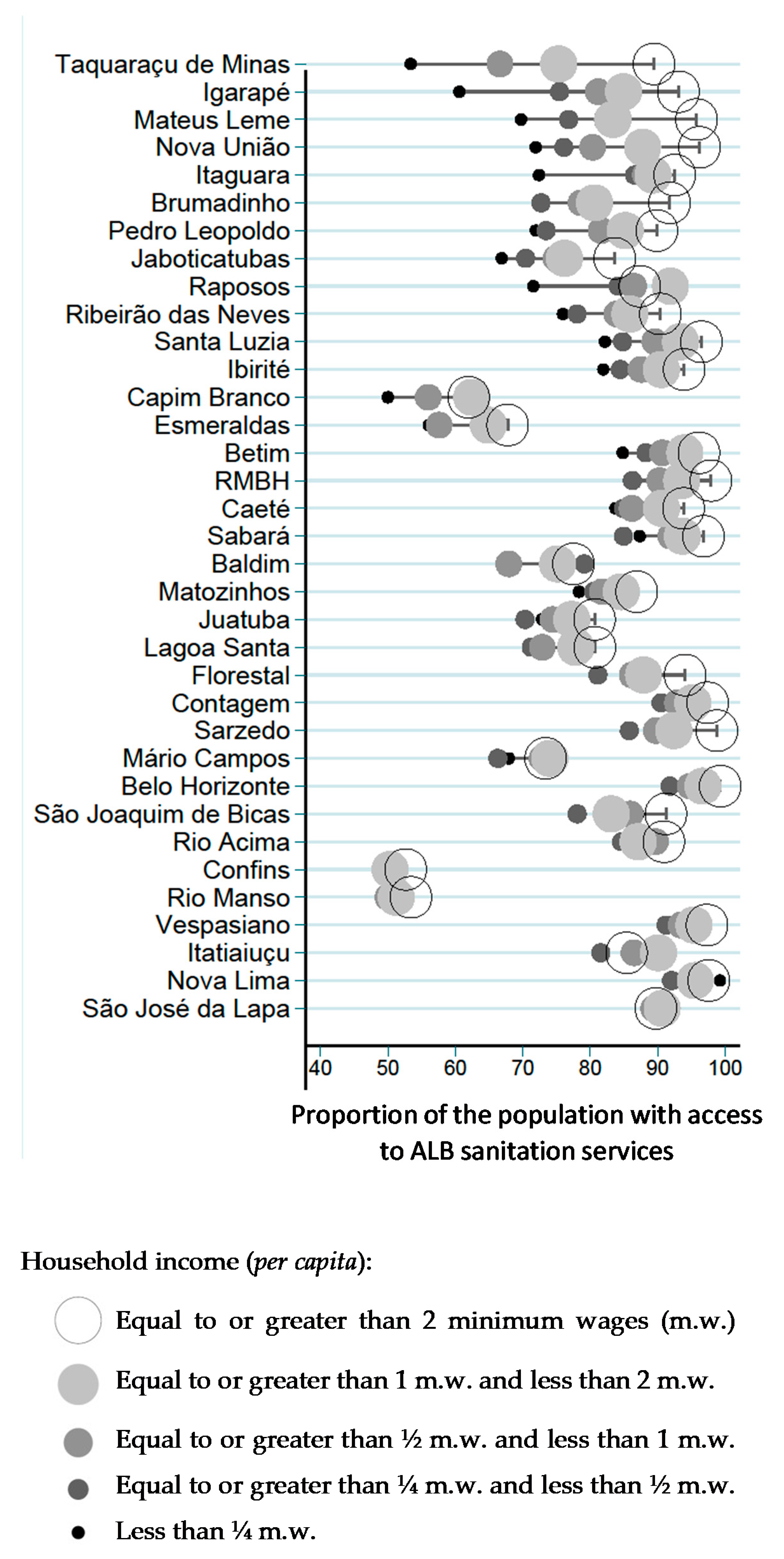
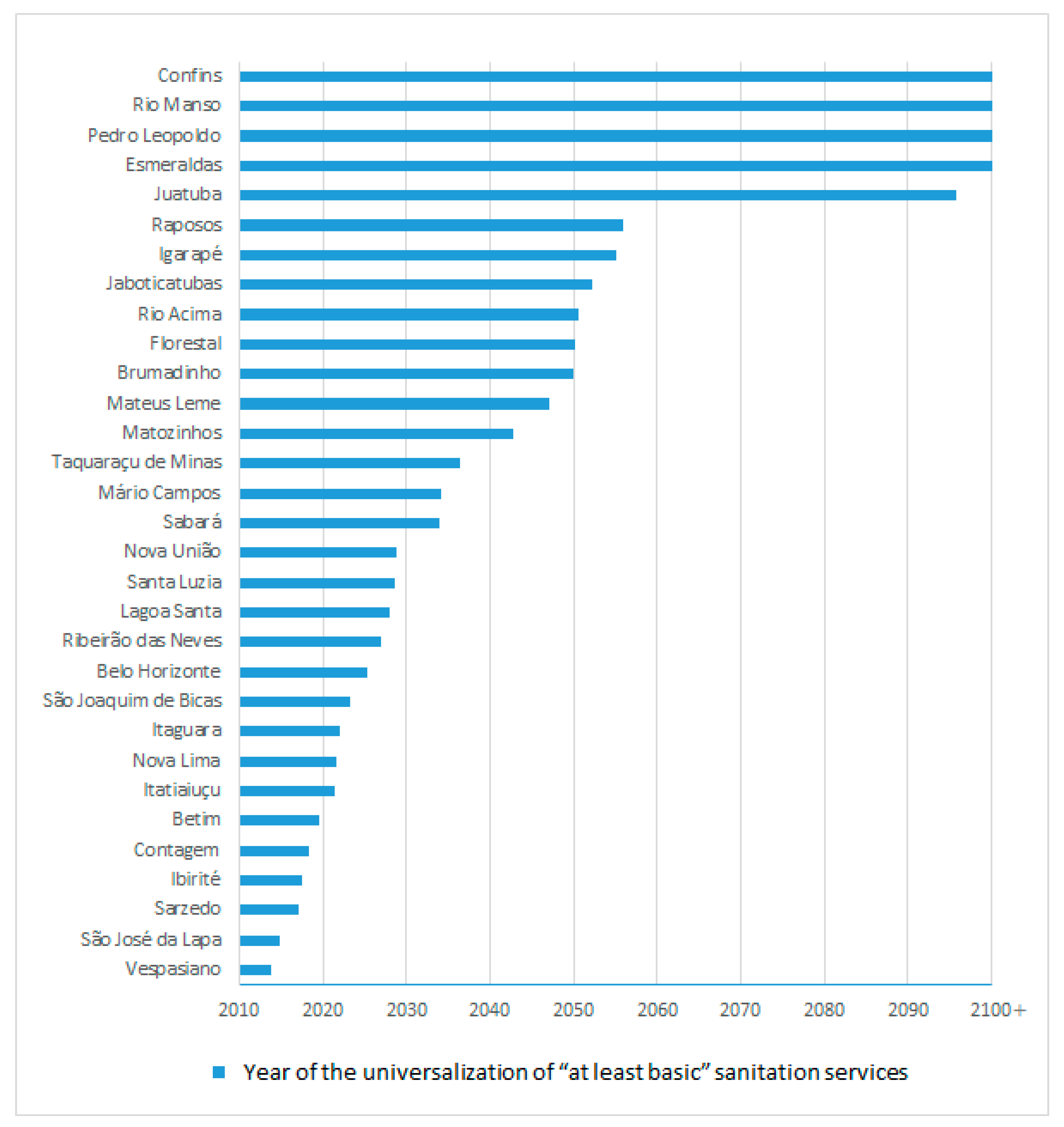
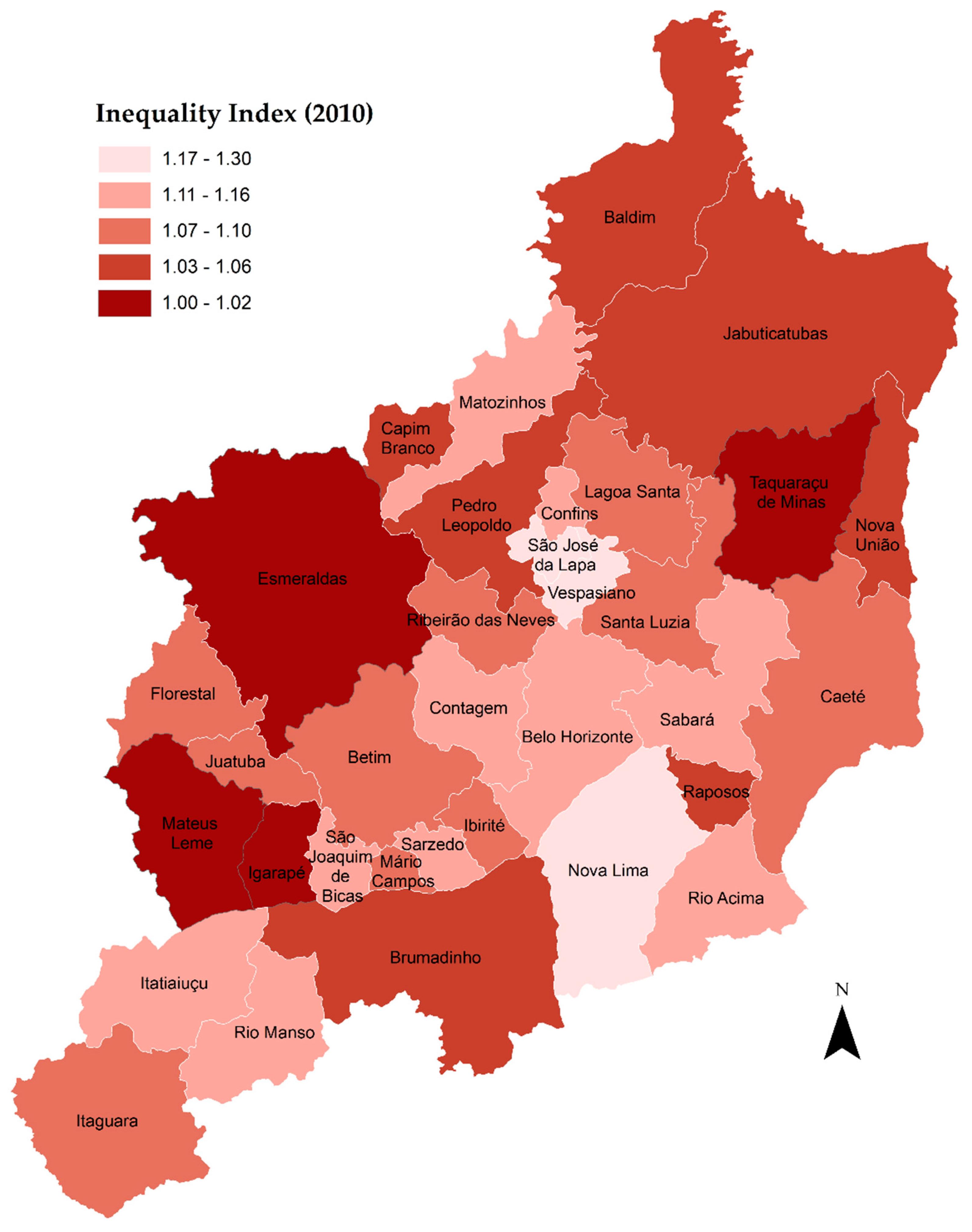
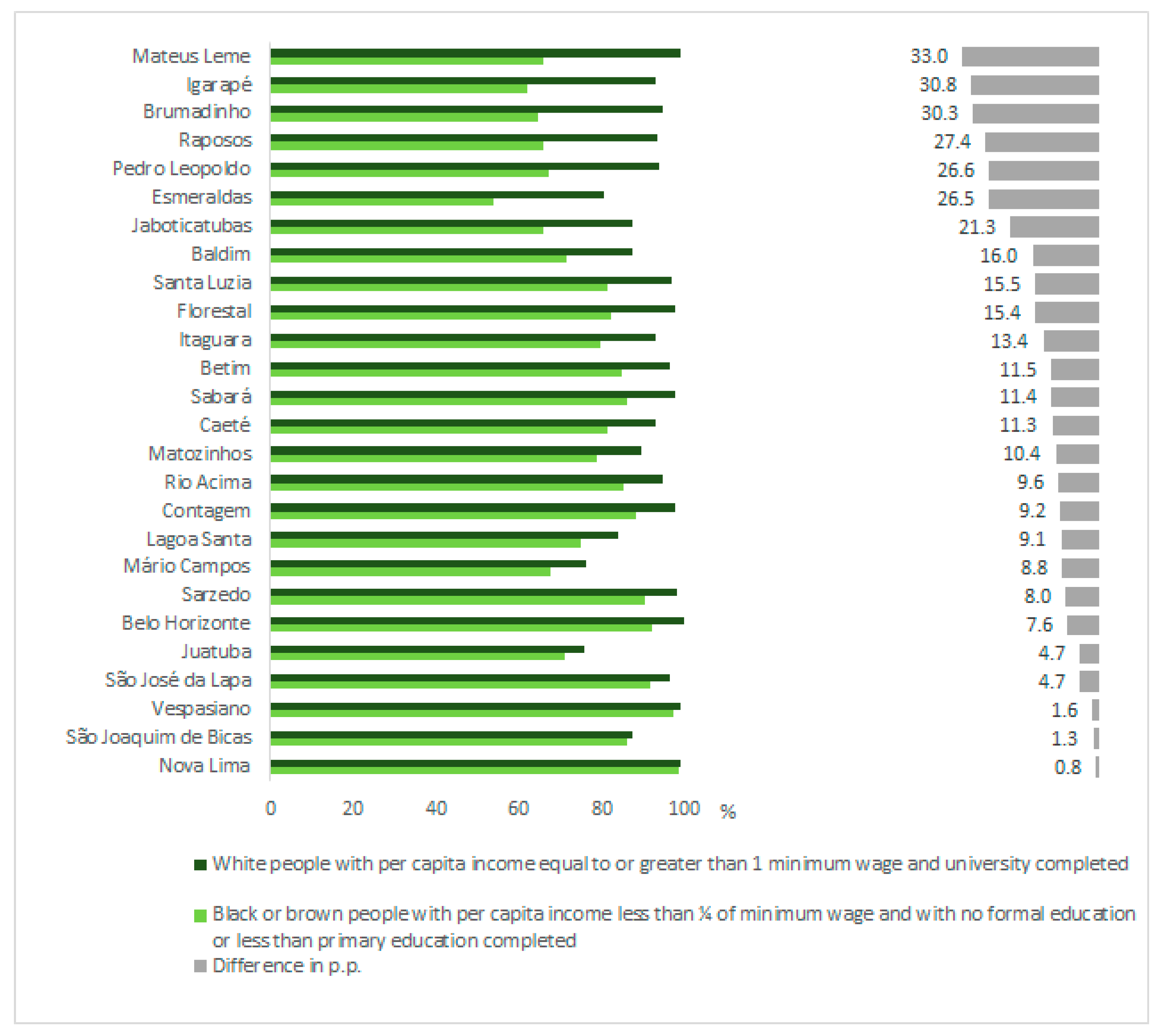
| Improved Facilities | Networked sanitation: |
| |
| On-site sanitation: | |
| |
| Unimproved Facilities | On-site sanitation: |
| |
| No Facilities | Open defecation |
| Service Level | Definition |
|---|---|
| Safely Managed | Use of improved facilities that are not shared with other households and where excreta are safely disposed of in situ or transported and treated offsite |
| Basic | Use of improved facilities that are not shared with other households |
| Limited | Use of improved facilities shared between two or more households |
| Unimproved | Use of pit latrines without a slab or platform, hanging latrines, or bucket latrines |
| Open Defecation | Disposal of human feces in fields, forests, bushes, open bodies of water, beaches, or other open spaces, or with solid waste |
| Type of Facility (JMP Classification) | Census Variable (in Portuguese) | Classification |
|---|---|---|
| Flush/toilet to piped sewer system | “Rede geral de esgoto ou pluvial” | Improved facility |
| Flush/toilet to septic tank | “Fossa séptica” | Improved facility |
| Traditional latrine | “Fossas rudimentares” | 50% improved and 50% unimproved |
| Pit latrine without slab/open pit and others | “Vala, rio, lago ou mar e outro” | Unimproved/no facilities |
| Variables | “Vulnerable” Group | “Non-Vulnerable” Group |
|---|---|---|
| Color or race | Black or brown | Whites |
| Educational attainment | No formal education or less than primary education completed | University completed |
| Household income (per capita) | Less than 1/4 minimum wage | Equal to or greater than one minimum wage |
© 2020 by the authors. Licensee MDPI, Basel, Switzerland. This article is an open access article distributed under the terms and conditions of the Creative Commons Attribution (CC BY) license (http://creativecommons.org/licenses/by/4.0/).
Share and Cite
Carvalho, R.C.d.; Nahas, M.I.P.; Heller, L. Localizing Sustainable Development Goal 6: An Assessment of Equitable Access to Sanitation in a Brazilian Metropolitan Region. Sustainability 2020, 12, 6776. https://doi.org/10.3390/su12176776
Carvalho RCd, Nahas MIP, Heller L. Localizing Sustainable Development Goal 6: An Assessment of Equitable Access to Sanitation in a Brazilian Metropolitan Region. Sustainability. 2020; 12(17):6776. https://doi.org/10.3390/su12176776
Chicago/Turabian StyleCarvalho, Rodrigo Coelho de, Maria Inês Pedrosa Nahas, and Léo Heller. 2020. "Localizing Sustainable Development Goal 6: An Assessment of Equitable Access to Sanitation in a Brazilian Metropolitan Region" Sustainability 12, no. 17: 6776. https://doi.org/10.3390/su12176776
APA StyleCarvalho, R. C. d., Nahas, M. I. P., & Heller, L. (2020). Localizing Sustainable Development Goal 6: An Assessment of Equitable Access to Sanitation in a Brazilian Metropolitan Region. Sustainability, 12(17), 6776. https://doi.org/10.3390/su12176776






